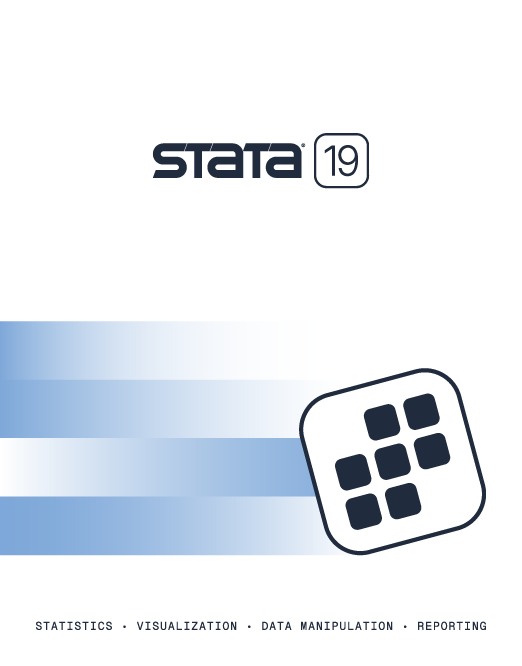This page announced updates in Stata 12. See a complete overview of all of
Stata's features.
Order |
What’s new in general statistics
- Contrasts, which is to say, tests of linear hypotheses involving factor
variables and their interactions from the most recently fit model, and
that model can be virtually any model that Stata can fit. Tests
include ANOVA-style tests of main effects, simple effects,
interactions, and nested effects. Effects can be decomposed into
comparisons with reference categories, comparisons of adjacent levels,
comparisons with the grand mean, and more.
- Pairwise comparisons of means, estimated cell means, estimated marginal
means, predictive margins of linear and nonlinear responses,
intercepts, and slopes. In addition to ANOVA-style comparisons,
comparisons can be made of population averages.
- Graphs of margins, marginal effects, contrasts, and pairwise
comparisons. Margins and effects can be obtained from linear or
nonlinear (for example, probability) responses.
- ROC adjusted for covariates, which is to say, you can model the ROC
curve and obtain coefficients, standard errors, and graphs.
Nonparametric and parametric estimation is supported.
- Estimation output improved:
- Baseline odds now shown, which is to say, the exponentiated
intercept is displayed by logistic and by logit with
option or. In fact, all estimation commands show
exponentiated intercepts when option eform() or its
equivalent is specified. For example, poisson shows the
baseline incidence rate when option irr is specified.
- Implied zero coefficients now shown. When a coefficient is omitted,
it is now shown as being zero, and the reason it was
omitted—collinearity, base, empty—is shown in the
standard-error column. (The word “omitted” is shown if
the coefficient was omitted because of collinearity.)
- You can set displayed precision for all values in coefficient tables
using set cformat, set pformat, and set
sformat. Or you may use options cformat(),
pformat(), and sformat() now allowed on all estimation
commands.
- Estimation commands now respect the width of the Results window.
This feature may be turned off by new display option nolstretch.
-
You can now set whether base levels, empty cells, and omitted are
shown using set showbaselevels, set showemptycells,
and set showomitted.
- test with coefficient names not using _b[ ] notation is
now allowed, even when the specified variables no longer exist in the
current dataset.
- areg now faster. areg is orders of magnitude faster when
there are hundreds of absorption groups, even if you are not running
Stata/MP.
- misstable summarize will now create a summary variable recording
the missing-values pattern.
- margins command supports contrasts.
- sfrancia uses a better algorithm. sfrancia now uses an
algorithm based on the log transformation for approximating the
sampling distribution of the W′ statistic for testing
normality. The old algorithm, using the Box–Cox transformation,
is available under version control or via the new boxcox option.
Based on simulation, the new algorithm is more powerful for sample
sizes greater than 1,000 and is comparable to the old algorithm for
sample sizes less than 1,000. Also, similarly to swilk,
sfrancia now allows you to suppress the treatment of ties when
option noties is used.
- logistic now allows option noconstant.
- Probability predictions now available. predict after count-data
models, such as poisson and nbreg, can now predict the
probability of any count or count range.
- Truncated count-data models now available. New estimation commands
tpoisson and tnbreg fit models of count-data outcomes
with any form of left truncation, including truncation that varies
observation by observation. These new commands supersede ztp
and ztnb.
- cnsreg checks for collinear variables prior to estimation and
has new option collinear, which keeps the collinear variables
instead of omitting them. The old behavior of always keeping collinear
variables is preserved under version control.
- ml improved,
- ml now distinguishes the Hessian matrix produced by
technique(nr) from the other techniques that compute a
substitute for the Hessian matrix. This means that ml will
compute the real Hessian matrix of second derivatives to determine
convergence when all other convergence tolerances are satisfied and
technique(bfgs), technique(bhhh), or
technique(dfp) is in effect. The old behavior was to use the
nrtolerance() value with the H matrix associated with
the technique() currently in effect to determine convergence;
this behavior is preserved under version control.
- ml has new option qtolerance() that distinguishes
itself from ntrol() when technique(bfgs),
technique(bhhh), or technique(dfp) is specified.
Option qtolerance() replaces nrtolerance() when
technique(bfgs), technique(bhhh), or
technique(dfp) is in effect.
- margins has new option estimtolerance() for setting
tolerance used to determine estimable functions.
Back to highlights
See New in Stata 19 to learn about what was added in Stata 19.
